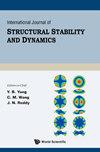Interfacial Debonding Detection in Concrete-Filled Steel Tubular (CFST) Columns with Modal Curvature-Based Irregularity Detection Indices
IF 3.4
3区 工程技术
Q2 ENGINEERING, CIVIL
International Journal of Structural Stability and Dynamics
Pub Date : 2023-10-12
DOI:10.1142/s0219455424501487
引用次数: 1
Abstract
This study investigates the effect of concrete-steel debonding on the modal dynamic properties, i.e. frequency values and vibration mode shapes, and deals with the identification of interfacial debonding zones in CFST columns. In this context, debonding, defined as a decrease in concrete stiffness at the connection with the steel tube by a depth of 3 mm, was analyzed through the frequency analysis of the column. The findings indicate that debonding results in a discernible disparity between the primary and secondary mode shapes, as assessed by the Modal Assurance Criterion (MAC). Furthermore, there is a reduction in the frequency values across all modes. This paper proposes the irregularity detection indices of the Modal Curvature Index (MCI), Modal Curvature-Slope Index (MCSI) and Modal Curvature-Curvature Index (MCCI) using the concept of curvature to detect the debonding zones. These indices indicate the relative extreme values of irregularities in debonding zones for all modes, such that the MCSI and MCCI show an increase in the height of irregularities regardless of negative or positive signs in a debonding zone as the damage severity in that zone increases.基于模态曲率不规则检测指标的钢管混凝土柱界面剥离检测
本文研究了混凝土-钢脱粘对混凝土模态动力特性(即频率值和振型)的影响,并研究了混凝土混凝土柱界面脱粘区识别问题。在这种情况下,通过对柱的频率分析来分析脱粘,即与钢管连接处混凝土刚度下降3mm的深度。研究结果表明,根据模态保证标准(MAC)的评估,脱粘会导致主模态和次模态振型之间存在明显的差异。此外,所有模式的频率值都有所降低。利用曲率的概念,提出了模态曲率指数(MCI)、模态曲率-斜率指数(MCSI)和模态曲率-曲率指数(MCCI)的不规则检测指标来检测脱粘区。这些指数反映了所有模式下脱粘区不规则性的相对极值,因此,随着脱粘区损伤严重程度的增加,MCSI和MCCI的不规则性高度都有所增加,无论该区域为负还是正。
本文章由计算机程序翻译,如有差异,请以英文原文为准。
求助全文
约1分钟内获得全文
求助全文
来源期刊
CiteScore
5.30
自引率
38.90%
发文量
291
审稿时长
4 months
期刊介绍:
The aim of this journal is to provide a unique forum for the publication and rapid dissemination of original research on stability and dynamics of structures. Papers that deal with conventional land-based structures, aerospace structures, marine structures, as well as biostructures and micro- and nano-structures are considered. Papers devoted to all aspects of structural stability and dynamics (both transient and vibration response), ranging from mathematical formulations, novel methods of solutions, to experimental investigations and practical applications in civil, mechanical, aerospace, marine, bio- and nano-engineering will be published.
The important subjects of structural stability and structural dynamics are placed together in this journal because they share somewhat fundamental elements. In recognition of the considerable research interests and recent proliferation of papers in these subjects, it is hoped that the journal may help bring together papers focused on related subjects, including the state-of-the-art surveys, so as to provide a more effective medium for disseminating the latest developments to researchers and engineers.
This journal features a section for technical notes that allows researchers to publish their initial findings or new ideas more speedily. Discussions of papers and concepts will also be published so that researchers can have a vibrant and timely communication with others.

 求助内容:
求助内容: 应助结果提醒方式:
应助结果提醒方式:


